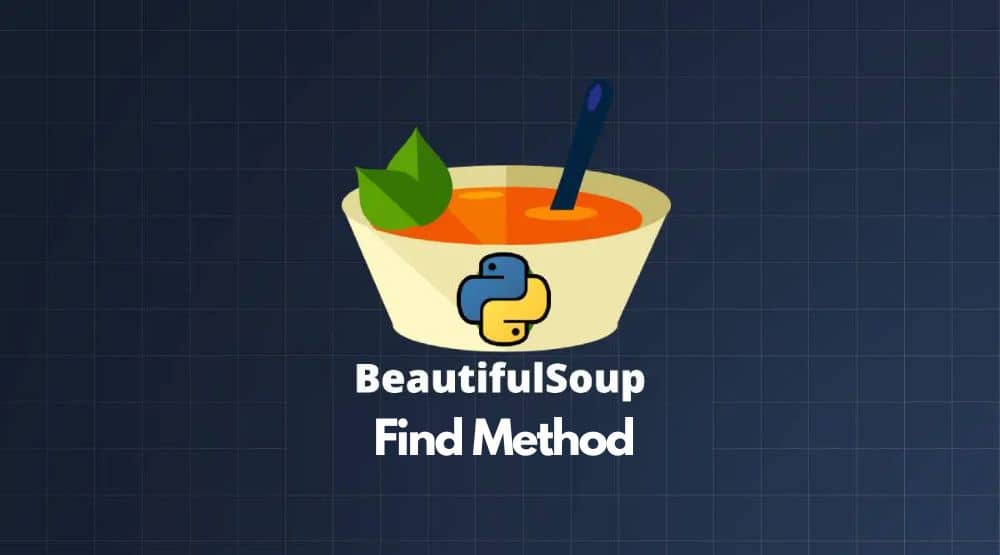The BeautifulSoup find method is one of the methods you can use to parse and extract the needed data in a web document. Come in now to learn how to make use of it for effective extraction of data from the web.

For some web targets, a dose of requests + BeautifulSoup is all you need to scrape them in terms of libraries needed. BeautifulSoup does a good job at wrapping your parser of choice (or its own chosen one) to help extract the data on a page. It does have support for multiple methods of identifying and extracting data ranging from the CSS selector soup.select() method to the likes of soup.find_all, and soup.find methods. This is not an ultimate guide for extraction. The article is focused mainly on soup.find() method. You will learn all you need to know about the soup.find method and how to make use of it.
What is Soup.find in BeautifulSoup?

The soup.find() method is found in the BeautifulSoup library. This method is used on a BeautifulSoup object to find out an element that matches its parameter. If you need to find an element you are sure is only one using its ID, element tag, or class, among others. If you use it to find an element when the number of elements that meet the criteria is more than one, then only the first element is returned — the other elements are left out.
The find method is quite different from the find_all method, which returns a list of elements, as the find method returns just an element. So why you will need to iterate through your result to get to the element of interest as in the case of find_all, you can act on it straight away if it is available, or it will return None.
How to Use the Soup.Find Method in BeautifulSoup

Now that you know what the method is, it is time for you to know how to make use of it to find the data you want. First, for landing on this page, I expect you already have BeautifulSoup installed on your computer. If you haven’t done that already, then you can read our BeautifulSoup installation guide. It is quite straightforward as BeautifulSoup is available on the PyPi and can be installed using the pip install command.
As stated earlier, the find method is meant for finding just one element or item on a page. When multiple elements meet the query, the tool will return just the first one — so do have a good understanding of the page you want to scrape before using the find method. Below are the ways you can find elements using the soup.find() method.
-
Find an Element by Tag Name
If your target on a page is available as unique in terms of tag — that’s, it does not share it tag with any other element, then scraping it is easy. Take, for instance, if you have only one table element, you can use the find method to locate it easily without writing any complicated code. Below is a code to do that using the BeautifulSoup find method.
#find table elements … soup = BeautifulSoup(page_html) table_element = soup.find(“table”) print(table_element)
As you can see above, I provided just the table tag name as an argument, and it returned it. If there were two tables, it would return just the first one it encounter.
-
Finding Element by Class or ID Name
In designing a web page, page elements are assigned IDs and class names for styling and interaction purposes. You can use this at your own end while web scraping. With this, you can decide to omit the tag name and just use the class name or ID. However, it is better you specify the tag name to make it more effective. Below is how to use find element to get an element using its ID or class name.
soup = BeautifulSoup(page_html) #find element by ID eID = soup.find(“a”, id=“price_link”) #find element by class name eClassName = soup.find(“tr”, class_=“product-items”) print(eID) print(eClassName)
In the code above, you can see that I added an underscore to class (class_). This is because it is a keyword in Python and not permissible.
-
Finding Elements by Attribute
Another way you can find an element is by using its attribute. Let's say you want to find a link element with the color red, you can use the find method. Below is a code on how to get that done.
soup.find(‘a’, attrs={‘color’: ‘red’})
FAQs About BeautifulSoup Find Method
Q. What Happened When the Find Method Does Not Get the Element?
If the element you want wasn’t found on the name, the find method will not return an error — it will return None instead. However, where an exception will be raised is when you try to act on the result. Because the result returned is None, if you try getting any detail from it or even acting on it, you will just hit an exception. To avoid this, you should always check the type of the element return and be sure it got an element before deciding to act upon it.
Q. What is the Best Scenario to Use Find in BeautifulSoup?
The find method is best used when you want to find just an element that you know is a unique class, ID, or attribute. If it shares any of these with any other element, then find won’t be the best method to use except if the element it shares this with does not have the same tag name. If you disregard this, you might end up getting the wrong element, as it will return the first element it encounters.
Q. What is the difference between Find and Find_All in BeautifulSoup?
From the name, you can tell that while find is meant for finding just one element, find_all is meant for finding multiple elements. Find will return the element you need, and you can start acting on it immediately. As for the find_all element, even if there is only one element, a list is returned to you. Have this at the back of your mind while using this method.
Conclusion
The find method, together with select and find_all, are the methods made available to you for accessing elements for the purpose of extracting data from them. Find is actually an easy-to-use method, as you can see from the above. However, you need to be careful when using it, as you could get the wrong element if the element you are after is not unique on the page.






